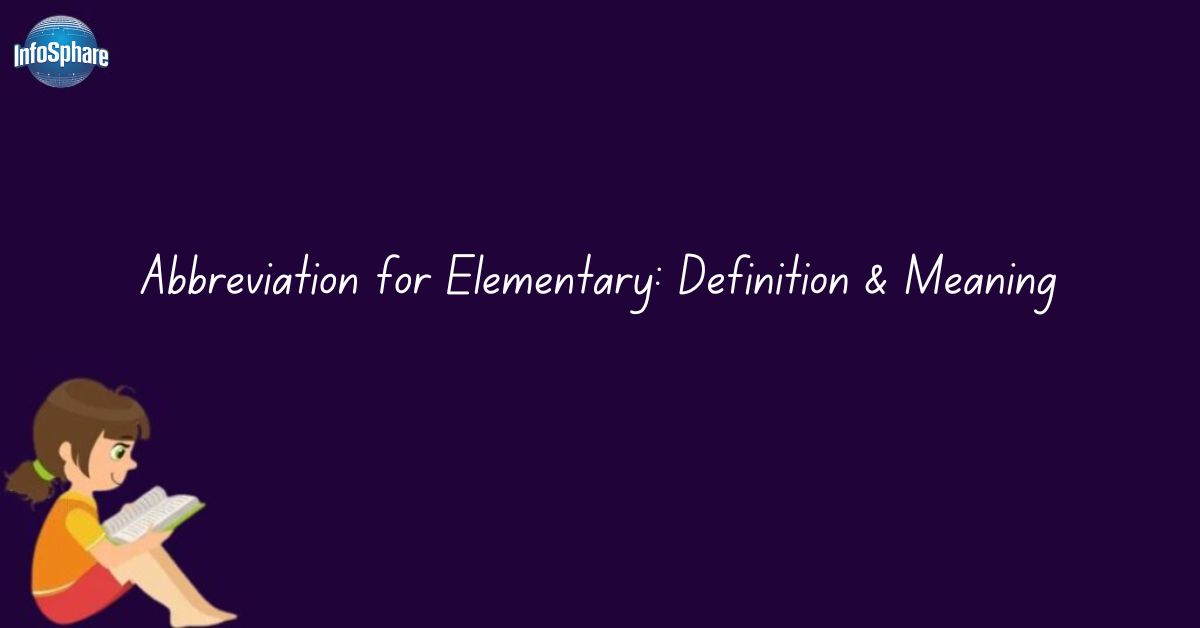When navigating the world of education, clarity and efficiency are paramount. One of the simplest ways to enhance communication is through abbreviations, especially for commonly referenced terms like “elementary.” This guide explores the abbreviation for elementary, covering its definition, history, and practical applications.
Whether you’re a teacher, student, or parent, understanding this abbreviation can streamline your interactions and documentation, making the educational experience more accessible. Join us as we uncover the significance of this essential term in educational contexts.
What Is the Abbreviation for Elementary?
The most widely recognized abbreviation for “elementary” is Elem. This concise form is commonly used in educational contexts, such as class schedules and grade lists, to enhance clarity and save space.
The Origins of the Word Elementary and Its Abbreviation
The term “elementary” derives from the Latin word elementarius, which means “about the elements.” Historically, it referred to the fundamental components of knowledge and nature, evolving to denote basic education as schooling systems developed.
Definition, Pronunciation, and Examples of “Elementary”
“Elementary” describes something fundamental or introductory. It refers to early stages of education, such as elementary school or basic mathematics.
- Pronunciation: el-uh-MEN-tuh-ree or el-uh-MEN-tree.
- Examples:
- “Students learn elementary science, covering basic topics.”
- “Grammar is an elementary aspect of language learning.”
Also Read this: CNC Meaning: Internet Urban Slang
Why Use Abbreviation for Elementary?
Abbreviations like “Elem.” are practical, especially in busy educational environments. They save time and space, making communication more efficient in contexts like forms, schedules, and memos.
When and Where to Use Abbreviation for Elem.
While “Elem.” is widely accepted in education, it’s best used in informal contexts such as internal documents, schedules, and notes rather than in formal communications with parents or the public.
Short Abbreviation for Elementary
The short form E.L.E.M. is also used in educational settings. This version is particularly handy in documents where space is limited, like registration forms and class schedules.
Acronym for Elementary
Technically, “elementary” does not have a specific acronym. While E.L.E.M. serves as a common abbreviation, acronyms typically consist of initials from multiple words.
How to Pronounce “Elementary”
To pronounce “elementary,” break it down phonetically:
- El (as in “elevator”)
- uh (a short sound)
- men (like “men”)
- tuh (quick “tuh” sound)
- ree (as in “tree”)
When Should You Use the Abbreviation?
Use “Elem.” in contexts where space is limited and clarity is needed, such as:
- Class schedules (e.g., “Elem. Math”)
- Quick notes or memos
- Forms and documents with limited space
Example Sentences Using “Elementary” and Its Abbreviation
- Elementary: “Learning addition is an elementary skill.”
- Abbreviation (E.L.E.M.): “Check the E.L.E.M. school schedule for events.”
Must Read this Magical Slang: Fyrtrd: A Word Full of Mystery and Emotion
Synonyms for Elementary
Some synonyms for “elementary” include:
- Basic
- Fundamental
- Introductory
- Simple
Antonyms for Elementary
Conversely, antonyms for “elementary” would include:
- Advanced
- Complex
- Challenging
- Sophisticated
The History of the Word Abbreviation for Elementary
“Elementary” has roots in Latin, referring to basic building blocks. Over time, its meaning evolved to signify essential knowledge, especially in early education, typically covering grades from kindergarten to 5th or 6th.
When Not to Use Abbreviation for Elementary
Avoid using abbreviations in formal writing, academic papers, or presentations, where clarity is paramount. In these contexts, the full term “elementary” should be used.
Example of the Word and Abbreviation in Context
- Elementary: “Reading is an elementary skill.“
- Abbreviation (E.L.E.M.): “The teacher assigned E.L.E.M. homework focusing on math.”
Personal Reflection: The Power of Abbreviations
In my experience in education, abbreviations like “Elem.” significantly enhance clarity and efficiency. They streamline processes like lesson planning and reporting, making communication more effective.
Wrapping It Up
Mastering the abbreviation for elementary not only enhances communication but also streamlines educational processes. Whether used in schedules, documents, or casual notes, Elem. serves as a practical tool for teachers, students, and parents alike.
By understanding its significance and proper usage, you can contribute to a more organized and efficient educational environment, making every interaction clearer and more effective. Embrace the power of this simple abbreviation as you navigate the world of education.
Frequently Asked Questions
What is the common abbreviation for elementary?
“Elementary” is often shortened to “Elem.”
How is “Elem.” used in school contexts?
Schools use “Elem.” in schedules and documents to refer to elementary levels.
Is “Elem.” appropriate in formal writing?
In formal writing, it’s better to use the full word “elementary” instead of “Elem.”
Are there other abbreviation for elementary”?
Some people use “E.L.E.M.” as an abbreviation, but “Elem.” is more common.
Why do we abbreviate “elementary”?
Abbreviations like “Elem.” save space and make writing quicker and clearer.
Must Read these magical slangs:
- What is the HYB Meaning in Text and Why It’s So Popular?
- NMMS Meaning in Text: Quick Guide with Examples

Welcome! I’m glad you’re here. My name is Thomas, and this blog is dedicated to English Grammar and more.
I started this blog to share my Grammar site, and it has evolved into a resource where I provide easy and practical tips to help you for better Grammar.



